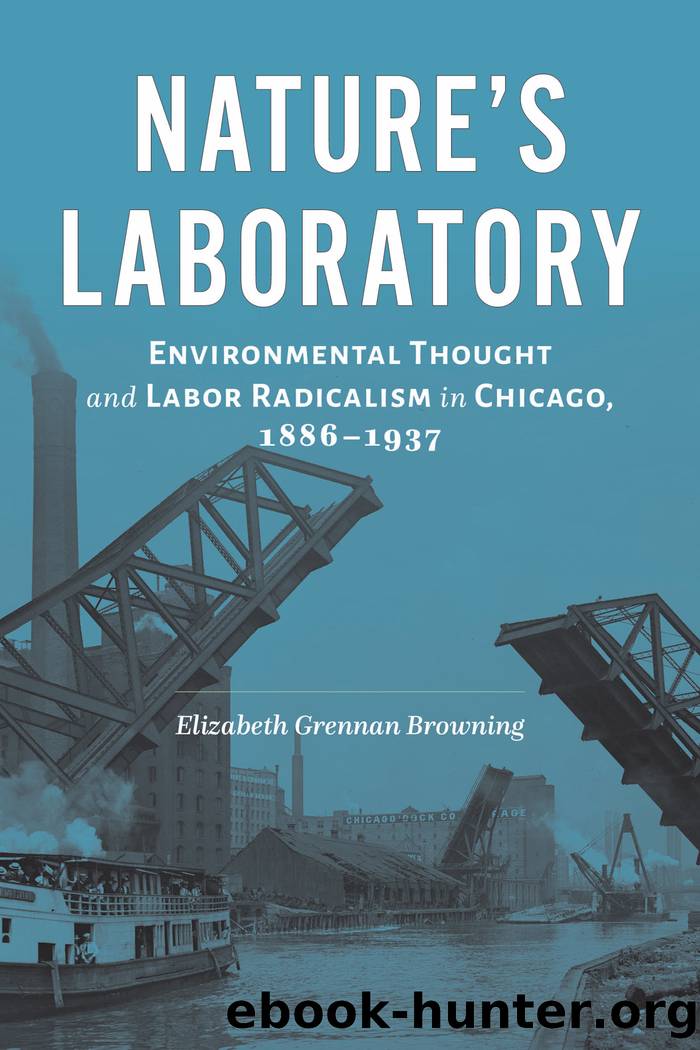Nature's Laboratory by Browning Elizabeth Grennan;

Author:Browning, Elizabeth Grennan;
Language: eng
Format: epub
Publisher: Johns Hopkins University Press
Published: 2022-02-15T00:00:00+00:00
Mirroring Jane Addamsâs appreciation for capturing the long history of labor and industry, Hamilton recounted the deep history of leadâone of the earliest metals to be smeltedâin order to make employers aware of their dangerous disregard of occupational health. In 1910, Hamilton explained that American employers mistakenly saw lead poisoning as resulting from workersâ neglect to wash their hands after handling lead. In fact, the breathing of dust and fumesâwhich the employees had little control overâinduced poisoning much more quickly and severely. Identifying lead as the oldest industrial poison besides carbon monoxide, Hamilton traced it to ancient Rome, where Pliny the Elder included lead poisoning among the âdiseases of the slavesâ alongside silicosis and mercurial poisoning. Observant physicians who foreshadowed modern occupational health, including Bernardino Ramazzini in eighteenth-century Italy and Louis Tanquerel des Planches in nineteenth-century France, had noted the dangers of exposure to lead dust in contrast with the relative safety of handling solid lead.70
In the early decades of the twentieth century, physicians had a difficult time diagnosing lead poisoningâs unusual and varied symptoms. Although diagnostic methodologies advanced during Hamiltonâs career to include chemical and microscopic examinations of blood and excreta and testing for nerve response, her initial studyâs methods âwere as crude as those of Tanquerel des Planches.â Namely, she relied on the âlead lineâ test, a physiological indicator of poisoning evidenced by a clear âdeposit of black lead sulphide in the cells of the lining of the mouth, usually clearest on the gum along the margin of the front teeth,â and caused by the sulphurated hydrogen emitted by decaying proteins left behind from chewing food.71 Relying on the biophysical processes of the worker to signal his status of health, Hamilton worried about the significant number of serious cases she had likely overlooked due to her lack of more sophisticated testing methods.
Her concerns were well founded since factory foremen unduly jeopardized workersâ health by disregarding sanitary measures. With no break in their six- to eight-hour shifts, Hamilton saw the enamel works employees eating lunch âwith lead-covered hands in a lead-laden atmosphere,â âsandwiches lying on dusty window sills,â and enamel particles coating the inside of workersâ lunchboxes.72 Given these lax safety standards, workers could not contain the lead dust to the factory walls. Coating workersâ lunchboxes and clothing, the dust inevitably invaded workersâ homes, where their familiesâ health subsequently suffered.
Chicagoâs most hazardous job with respect to lead poisoning was in service to a luxury product that only the wealthiest could afford to consume: Pullman cars. Chock-full of white lead, Pullmanâs paint was so dangerous that the companyâs painters suffered a high rate of severe acute lead poisoning. Recent immigrants from Hungary, Serbia, and Poland were the only workers willing to take the dangerous job of sanding and painting the cars. In light of the severe occupational risks Pullman workers faced, Hamilton found the companyâs medical department entirely inadequate. Unable to reason with Pullmanâs administration, Hamilton took her complaints to Jane Addams in 1912. Addams made use of her influential network by alerting a wealthy Pullman stockholder.
Download
This site does not store any files on its server. We only index and link to content provided by other sites. Please contact the content providers to delete copyright contents if any and email us, we'll remove relevant links or contents immediately.
Harry Potter and the Goblet Of Fire by J.K. Rowling(3027)
Never by Ken Follett(2873)
Shadow of Night by Deborah Harkness(2710)
Ogilvy on Advertising by David Ogilvy(2678)
Zero to IPO: Over $1 Trillion of Actionable Advice from the World's Most Successful Entrepreneurs by Frederic Kerrest(2377)
The Man Who Died Twice by Richard Osman(2291)
Machine Learning at Scale with H2O by Gregory Keys | David Whiting(2269)
Book of Life by Deborah Harkness(2259)
How Proust Can Change Your Life by Alain De Botton(2256)
My Brilliant Friend by Elena Ferrante(2219)
0041152001443424520 .pdf by Unknown(2214)
The Tipping Point by Malcolm Gladwell(2202)
How to Pay Zero Taxes, 2018 by Jeff A. Schnepper(2095)
Will by Will Smith(2033)
Purple Hibiscus by Chimamanda Ngozi Adichie(1979)
Hooked: A Dark, Contemporary Romance (Never After Series) by Emily McIntire(1933)
Borders by unknow(1780)
Rationality by Steven Pinker(1761)
Daughter of Smoke and Bone by Laini Taylor(1739)
